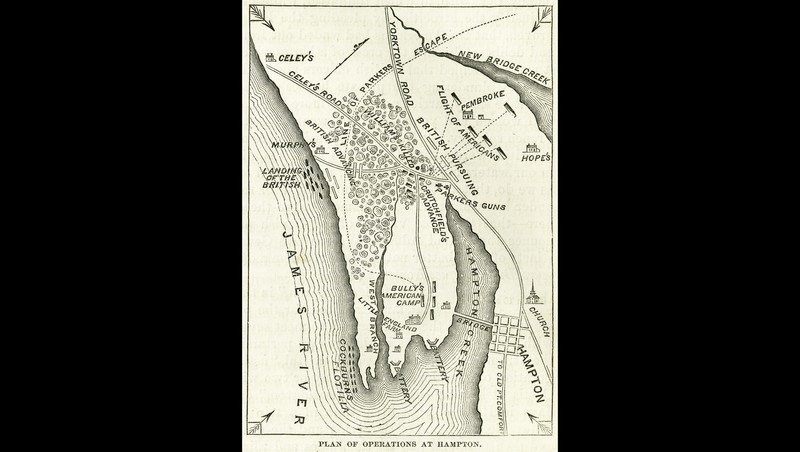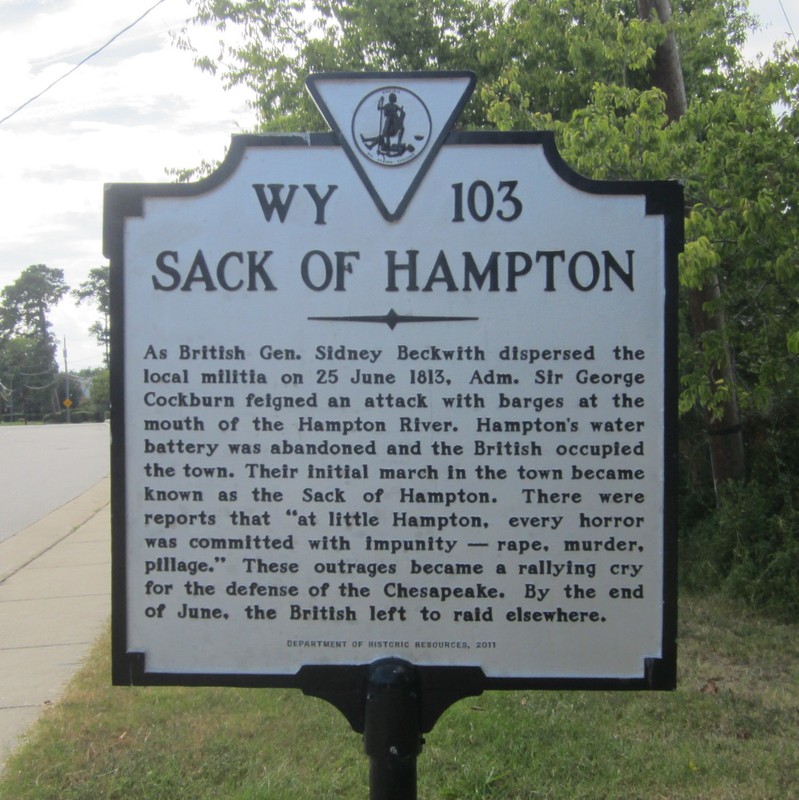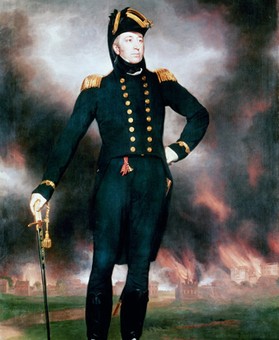Battle of Hampton (1812)
Introduction
Text-to-speech Audio
Images
An illustration of Hampton burning

Map of military operations around Hampton

"Sack of Hampton" historical marker

Rear Admiral George Cockburn, who commanded British naval forces at Hampton

Backstory and Context
Text-to-speech Audio
In early 1813, the British Royal Navy arrived in the Chesapeake Bay. The War of 1812 was less than a year old, and Great Britain hoped that by imposing a blockade on the Chesapeake, they could damage the local economy, undercut American morale, and divert American resources from the vulnerable Canadian front. On June 23, 1813, British commander Rear Admiral John Warren took the offensive and attacked Craney Island, which protected Norfolk. The attack went disastrously awry; the British completely failed to capture Norfolk and suffered nearly 80 killed and wounded along the way.
The failed attack on Norfolk embarrassed Admiral Warren and his British forces. Almost immediately following the defeat, Admiral Warren and his subordinate commanders agreed to attack Hampton, a small village across the James River. Hampton reportedly held an American militia encampment, but the British may simply have desired immediate redress for the Norfolk disaster.
Hampton was indeed guarded by local militia, just under 450 Virginians and seven artillery pieces under the command of Major Stapleton Crutchfield. Expecting an amphibious assault from the British via the James River, Major Stapleton ordered his inexperienced militia to construct earthworks facing the junction of James River and Hampton Creek on the grounds of ironically-named Little England, a local plantation home.
The British planned a two-prong assault against the Virginia militia. A British flotilla under Rear Admiral George Cockburn would advance against directly against the militia’s riverside batteries. This demonstration would distract the Americans while a force of 2,600 sailors, marines, and infantry under Colonel Thomas Sidney Beckwith landed north of the Americans’ position and attack from the rear. The trapped Americans would be destroyed or forces to surrender.
Colonel Beckwith’s landing party came ashore around 3:30 a.m. on June 25, 1813. As his men disembarked and began marching inland towards the Virginians encampment, the vanguard consisted of Chasseurs Britanniques, also known as the Company of Independent Foreigners. This grandly named outfit actually consisted of several hundred French soldiers taken prisoner by the British in Europe. Rather than prison, they agreed to serve in the British army in America, and these from soldiers of Napoleon now half-heartedly led the British advance into the Virginia woods. As Beckwith’s force crept towards the American rear, Admiral Cockburn’s flotilla noisily engaged in an artillery duel with Major Crutchfield’s artillery. Although pickets warned Crutchfield that a British force had landed north of his position, he was unsure which British attack constituted the main assault. Crutchfield ordered a small force under Captain Richard Servant to probe the advancing British to the north.
Captain Servant’s Virginia riflemen stumbled onto the advance of the Chasseurs Britanniques. A sharp firefight ensued the early morning darkness. As an American militia officer recounted, “They [the Chasseurs] then gave the most incessant fire that I ever heard in my life.”[1] The gunfire to his north convinced Major Crutchfield the main British attack was not the fleet to his front, but rather the British force to his rear, and he ordered his men to abandon their riverside trenches and advance quickly north to meet the enemy.
A little after 6 a.m., the American militia encountered the main British force in a cornfield at the intersection Celey’s and Yorktown Roads. The brave Americans formed into line of battle and advanced, but they were met with a withering blast of British artillery fire. They were also met with rocket fire, as the British employed Congreve rockets during the Chesapeake Campaign. Although notoriously inaccurate, the piercing shriek of the rockets often unnerved inexperienced troops, as it did with Americans. The Americans attempted one more advance but broke and fled in the face of the well-directly British fire.
Major Crutchfield managed to secure the help of Captain Servant’s riflemen and two other militia companies in a fighting retreat. Although unable to stop the British advance towards Hampton, Crutchfield’s rearguard action allowed many of his panicked militiamen to escape British clutches.
By 7:30 a.m., the fight for Hampton was over. The Virginia militia had been decisively defeated and scattered, suffering 7 killed, 12 wounded, and 11 missing. The British reported 5 dead, 33 wounded, and 10 missing; the British casualties are a testament to the initial stoutness of the American defense.
The British policy in the Chesapeake was to destroy any town that resisted the advance of the British, and Hampton was to be no exception. The sack of Hampton, however, proved especially brutal. The British plundered and burned the town, and several reports indicated the French Chasseurs were allowed to run wild. Houses and business were looted and burned, including St. John’s Episcopal Church. Citizens were robbed of belongings. Reports of rape and murder emerged. British officer Lieutenant Colonel Charles Napier confessed that “Every horror was committed with impunity, rape, murder, pillage; and not a man was punished.”[1]
News of Hampton’s sacking spread quickly. Virginia militia commander Brigadier General Robert Taylor reported, “I have heard with grief and astonishment of the excesses to both property and persons committed by the land troops who took possession of Hampton.”[2] American newspapers reported on the terrible incident across the country. The sacking of Hampton undid the value of capturing the town in the first place; anger at the town’s sacking bolstered resistance to the British. As historian Stanley Quick notes, “The Battle of Hampton had no real importance tactically, but its strategic implications would haunt the British…the United States turned an insignificant defeat into a significant victory.”[1]
Today, a state historical marker acknowledges the Battle of Hampton and the subsequent sacking of the town in June 1813. The local Hampton History Museum has also worked to interpret the War of 1812 in the Chesapeake with various exhibits and events. Included in the Museum's holdings is the "Rutherford Rifle," a rifle crafted by Archibald Rutherford believed to have been used by Virginia militia at the Battle of Hampton.
Sources
1. Stanley L. Quick and Chipp Reid. Lion in the Bay: The British Invasion of the Chesapeake, 1813-1814. Annapolis, MD: Naval Institute Press, 2015.
2. Christopher T. George. Terror on the Chesapeake: The War of 1812 on the Bay. Shippensburg, PA: White Mane Books, 2000.
3. John R. Elting. Amateurs, to Arms! A Military History of the War of 1812. New York: Da Capo Books, 1995.
4. Charles P. Neimeyer. The Chesapeake Campaign 1813-1814. Washington, D.C.: Center for Military History, 2014. Digitized. https://history.army.mil/html/books/074/74-5/CMHPub_74-5.pdf
5. Stuart L. Butler. "Defending Norfolk." Prologue. Spring 2013. Web. Accessed December 19, 2020. https://www.archives.gov/files/publications/prologue/2013/spring/norfolk.pdf
6. Mark St. John Erickson. "War of 1812: British raiders pillage Hampton." June 22, 2018. Daily Press. Web. Accessed December 19, 2020. https://www.dailypress.com/history/dp-nws-war-of-1812-hampton-20130622-story.html
7. Sanhita Sen. "Rutherford Rifle Returns to Hampton." July 25, 2004. Daily Press. Web. Accessed December 21, 2020. https://www.dailypress.com/news/dp-xpm-20040725-2004-07-25-0407230308-story.html
Daily Press: https://www.dailypress.com/history/dp-nws-war-of-1812-hampton-20130622-story.html
Daily Press: https://www.dailypress.com/history/dp-nws-war-of-1812-hampton-20130622-story.html
Bernard Fisher, HMDB: https://www.hmdb.org/m.asp?m=76817
National Park Service: https://www.nps.gov/people/george-cockburn.htm
